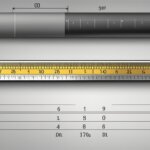Table of Contents
A wavelength is the distance between identical points (adjacent crests) in the adjacent cycles of a waveform signal. It can be measured in meters, centimeters, millimeters, or nanometers. Wavelength is inversely related to frequency, with higher frequency signals having shorter wavelengths. In the case of sound waves, they are the patterns of disturbance caused by the movement of energy traveling through a medium, while electromagnetic waves are created by vibrations between an electric field and a magnetic field.
Understanding the concept of wavelength is crucial in comprehending the behavior and characteristics of various waveforms. Whether it’s a sound wave propagating through air or an electromagnetic wave transmitting data, the measurement of a wavelength can provide valuable insights.
In this article, we will dive deeper into how to measure and calculate wavelengths, explore their applications in fiber optics and wireless networks, and discuss the relationship between frequency and wavelength. So, let’s get started!
How to Measure a Wavelength
In order to measure the wavelength of a wave, various instruments can be utilized, such as optical spectrometers or optical spectrum analyzers. These instruments are specially designed to analyze and measure the wavelengths of different waves. By using these devices, scientists and researchers can determine the exact wavelength of a wave with great precision.
Wavelengths are measured using different units, depending on the scale of the wave. For larger waves, such as those in the radio frequency range, wavelengths are usually measured in kilometers or meters. For smaller waves, like those in the optical spectrum, wavelengths are measured in millimeters or nanometers. The choice of unit depends on the specific application and the range of wave frequencies being analyzed.
To calculate the frequency of a wave, one can use the following equation: λ = 300/f, where λ represents the wavelength in meters and f represents the frequency in megahertz. This formula allows researchers to determine the frequency of a wave based on its known wavelength or vice versa.
“The accurate measurement of wavelengths is crucial in many scientific fields, such as physics, chemistry, and optics. Optical spectrometers and spectrum analyzers play a vital role in providing precise data about wavelengths, enabling scientists to understand the behavior and properties of different waves in the electromagnetic spectrum.”
Advantages of Optical Spectrometers and Spectrum Analyzers
Optical spectrometers and spectrum analyzers offer several advantages when it comes to measuring wavelengths:
- High accuracy: These instruments are designed to provide precise measurements, ensuring accurate data for research and analysis.
- Wide wavelength range: They can measure wavelengths across a broad range, making them suitable for various applications.
- Fast and efficient: Optical spectrometers and spectrum analyzers can analyze multiple wavelengths simultaneously, saving time and increasing productivity.
- Non-destructive: These instruments allow for non-destructive analysis, preserving the integrity of the wave being measured.
By using optical spectrometers and spectrum analyzers, scientists and engineers can effectively measure wavelengths and gain valuable insights into the properties and characteristics of different waves in the electromagnetic spectrum.
| Wave Type | Wavelength | Unit of Measurement |
|---|---|---|
| Radio waves | 1 km – 100 m | Kilometers and meters |
| Microwaves | 1 m – 1 mm | Meters and millimeters |
| Infrared waves | 1 mm – 750 nm | Millimeters and nanometers |
| Visible light | 750 nm – 400 nm | Nanometers |
| Ultraviolet waves | 400 nm – 10 nm | Nanometers |
| X-rays | 10 nm – 0.01 nm | Nanometers |
| Gamma rays | less than 0.01 nm | Nanometers |
How to Calculate Wavelength
Calculating the wavelength of a wave is a straightforward process that requires knowledge of the wave velocity and frequency. By using a simple formula, one can determine the wavelength in meters.
The formula to calculate wavelength is given by:
λ = v/f
Where:
- λ represents the wavelength in meters
- v is the wave velocity in meters per second
- f denotes the frequency in hertz
This formula allows us to find the distance between two successive points on a wave. By dividing the wave’s velocity by its frequency, the resulting value represents the length of one complete cycle of the wave.
For example, let’s say we have a wave with a velocity of 300 m/s and a frequency of 50 Hz. Using the formula, we can calculate the wavelength as follows:
λ = 300/50
λ = 6 meters
Hence, the wavelength of the given wave is 6 meters.
This method of calculating wavelength is applicable to various types of waves, including sound waves, electromagnetic waves, and water waves. Understanding the wavelength provides valuable insights into the characteristics and behavior of these waves.
Importance of Calculating Wavelength
Calculating the wavelength is crucial for scientists, engineers, and researchers in various fields. It enables them to:
- Design and optimize antennas for wireless communication systems
- Create efficient acoustics for concert halls and auditoriums
- Develop strategies for data transmission in fiber optic networks
- Study the properties of different waves in physics and chemistry
The ability to calculate wavelength empowers professionals to make informed decisions and solve complex problems related to waves and their applications in the real world. It is an essential skill for anyone working in fields where the understanding of wave phenomena is necessary.
To visualize the concept of wavelength, take a look at the image below:
Wavelength in Fiber Optics
In the realm of fiber optics, wavelength division multiplexing (WDM) plays a crucial role in enhancing the efficiency of data transmission. By utilizing WDM technology, different wavelengths of light can be transmitted simultaneously through a single fiber optic cable. This innovative approach significantly increases the capacity of optical networks, allowing for higher data rates and seamless connectivity.
One of the key advantages of wavelength division multiplexing is its ability to transmit data over different channels, each operating at a specific wavelength. This enables multiple signals to occupy the same fiber optic cable simultaneously, thereby maximizing the utilization of the infrastructure. As a result, optical networks can handle an enormous amount of data traffic with minimal interference and no compromise on transmission quality.
The most commonly used wavelengths in fiber optics are 850 nm, 1,300 nm, and 1,550 nm. These wavelengths are carefully chosen to optimize the efficiency and performance of optical networks. By leveraging specific wavelengths, fiber optic systems can achieve high-speed and long-distance data transfer, catering to a wide range of applications such as telecommunications, internet connectivity, and data centers.
In conclusion, wavelength division multiplexing revolutionizes the field of fiber optics, allowing for efficient and high-capacity data transmission. By harnessing the power of different wavelengths, optical networks can overcome bandwidth limitations and meet the ever-growing demands of our connected world.

Advantages of Wavelength Division Multiplexing in Fiber Optics:
- Increased data transmission capacity
- Simultaneous transmission of multiple wavelengths
- Optimized utilization of fiber optic infrastructure
- Enhanced efficiency and performance of optical networks
Commonly Used Wavelengths in Fiber Optics:
| Wavelength | Description |
|---|---|
| 850 nm | Commonly used for short-range transmission, such as within data centers |
| 1,300 nm | Optimal for medium-range transmission, offering a balance between distance and signal loss |
| 1,550 nm | Ideal for long-range transmission, known for its low signal attenuation |
Different Types of Waveforms
In the world of waveforms, there are four fundamental types that shape the flow of energy and information: the sine wave, square wave, triangle wave, and sawtooth wave. Each waveform has its distinct characteristics, making them valuable in different applications.
Sine Wave
The sine wave is a smooth, continuous waveform that oscillates in a periodic manner. It is characterized by its symmetrical curve, resembling the shape of a perfect circle. The sine wave is fundamental to understanding the nature of periodic behavior in various phenomena, such as alternating current (AC) signals, sound waves, and vibrations.
Square Wave
Unlike the sine wave, the square wave transitions abruptly between two levels, creating sharp, right-angle turns. It rises instantaneously from one level to another and remains at that level until it drops back down. Square waves are commonly used in digital electronics, clock signals, and pulse width modulation (PWM) applications.
Triangle Wave
The triangle wave is a waveform that linearly increases and decreases over time, forming a triangular shape. It closely resembles a ramp function, steadily rising and falling without sudden changes in direction. Triangle waves are often used in audio synthesis, musical instruments, and modulation techniques.
Sawtooth Wave
The sawtooth wave combines elements of both the triangle wave and the square wave. It has a linear increase followed by an abrupt drop, creating a saw-like pattern. Sawtooth waves are commonly found in music synthesis, signal generation, and certain types of testing applications.
Understanding the different types of waveforms and their properties is essential in various fields, from audio engineering and telecommunications to physics and electronics. Each waveform brings its unique characteristics, serving specific purposes in different applications.
Relationship between Frequency and Wavelength
Frequency and wavelength are fundamental properties that define the characteristics of waves, including electromagnetic waves. Understanding their relationship is crucial in comprehending the behavior and properties of various waveforms.
Frequencies refer to the number of oscillations or cycles a wave completes in a specific time period. They are measured in hertz (Hz), which represents the number of cycles per second. On the other hand, wavelengths represent the distance between successive points in a wave. For example, in electromagnetic waves, wavelengths are the spatial separation between consecutive crests or troughs.
Frequency and wavelength are intricately related. As the frequency of a wave increases, its wavelength decreases, and vice versa. This inverse relationship can be illustrated by the following equation:
Wavelength (λ) = Speed of Light (c) / Frequency (f)
The formula highlights that wavelength is inversely proportional to frequency. Consequently, higher frequency waves have shorter wavelengths, while lower frequency waves have longer wavelengths.
| Frequency | Wavelength |
|---|---|
| High | Short |
| Low | Long |
It is important to note that energy in a wave is directly proportional to its frequency and inversely proportional to its wavelength. This principle holds true for all types of waves, including electromagnetic waves.
In the electromagnetic spectrum, which encompasses a wide range of frequencies and wavelengths, all electromagnetic waves travel at the same speed, known as the speed of light. Despite their varying frequencies and wavelengths, these waves propagate through space or a medium at a consistent velocity.
By understanding the relationship between frequency and wavelength, we gain insights into the behavior of waves and their applications across various fields, such as communication, astronomy, and technology.
Wavelengths in Wireless Networks
In the realm of wireless networks, the consideration of wavelengths plays a crucial role. As we delve into the world of Wi-Fi, we encounter a variety of frequencies, each with its unique characteristics. One key principle to bear in mind is that higher frequencies correspond to shorter wavelengths. This means that Wi-Fi signals operating at higher frequencies face more challenges when it comes to penetrating obstacles like walls and floors.
Consequently, devices operating at higher frequencies might need an extra boost in power to attain comparable speeds and cover similar distances as their counterparts working at lower frequencies. To overcome this hurdle, engineers strive to strike an optimal balance between signal penetration and performance.
By understanding the effects of wavelengths on signal propagation, wireless network designers and manufacturers can fine-tune their products to maximize both coverage and reliability. This knowledge empowers them to create devices capable of transmitting Wi-Fi signals that can effectively navigate obstacles and reach their intended destinations. With continual advancements in technology, wireless networks are constantly evolving to offer improved connectivity and seamless user experiences.
FAQ
What is a wavelength?
A wavelength is the distance between identical points (adjacent crests) in the adjacent cycles of a waveform signal. It can be measured in various units such as meters, centimeters, millimeters, or nanometers.
How can a wavelength be measured?
Wavelengths can be measured using instruments like optical spectrometers or optical spectrum analyzers. They are measured in units such as kilometers, meters, millimeters, or nanometers.
How to calculate the wavelength of a wave?
The wavelength of a wave can be calculated by dividing the wave’s velocity by its frequency. The formula is λ = v/f, where λ is the wavelength in meters, v is the wave velocity in meters per second, and f is the frequency in hertz.
What is wavelength division multiplexing (WDM) in fiber optics?
Wavelength division multiplexing (WDM) is a technique used in fiber optics to increase the capacity of data transmission. It allows different wavelengths of light to be transmitted through a single fiber, thereby increasing the capacity of optical networks.
What are the different types of waveforms?
The four basic types of waveforms are sine wave, square wave, triangle wave, and sawtooth wave. Sine waves have a steady curve, square waves have sharp, right-angle turns, triangle waves increase and decrease in a straight line, and sawtooth waves are a hybrid of triangle and square waves.
Frequency and wavelength are closely related in waves. Higher frequency waves have shorter wavelengths, while lower frequency waves have longer wavelengths. The energy of a wave is directly proportional to its frequency and inversely proportional to its wavelength.
How do wavelengths affect wireless networks?
In wireless networks, wavelengths are an important factor to consider. Wi-Fi operates at various frequencies, and higher frequencies have shorter wavelengths. Signals with shorter wavelengths have more difficulty penetrating obstacles like walls and floors, so devices operating at higher frequencies may require more power to achieve similar speeds and distances as devices operating at lower frequencies.












